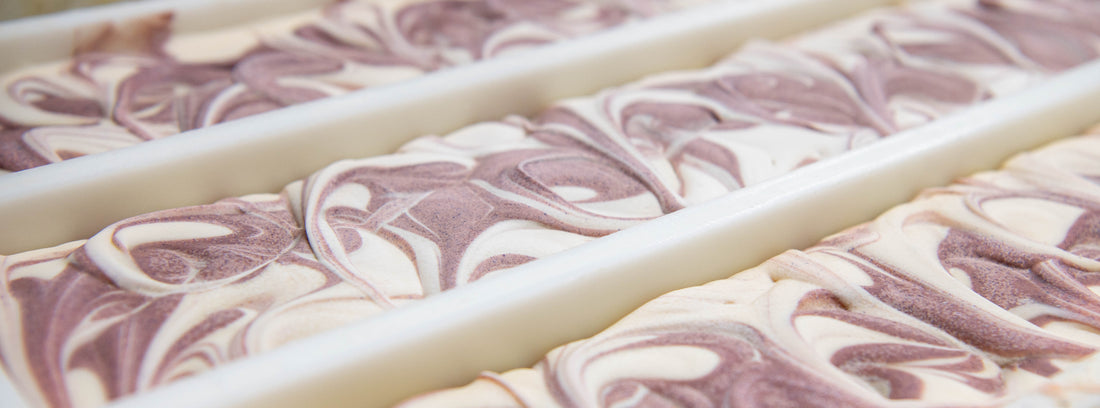Soap is made during a chemical reaction called Saponification. The word literally means "soap making" or "turning into soap" as "sapo" is the Latin word for soap. With cold process soapmaking (the soapmaking method here at Goat Milk Stuff), you combine an acid and a base and this produces soap and glycerin.
Acid (Fats/Oils) + Base (Lye) = Soap + Glycerin
What are the acids in the saponification process?
The acid is whichever fats and/or oils are used to make the soap. Each acid is made up of fatty acids and glycerol. Examples of fats and oils used in Goat Milk Stuff soaps are olive oil, castor oil, and coconut oil (and others).
When making soap, the choice of which specific fats and oils to use as well as their proportions is critical. Each of these acids, has specific properties that they will impart to the finished soap. For example, coconut oil gives the finished soap a bubbly lather, whereas olive oil will give a more lotion-like lather.
At Goat Milk Stuff, we spend a lot of time and resources testing different fat and oil blends. Small variations can have big impacts on the soap. We are confident our fat/oil blends produce wonderful goat milk soaps. We also know that these ingredients and formulas hold up over time.
What is the base in the saponification process?
The base is lye. The type of lye depends on which type of soap you are making. We use use sodium hydroxide for bar soap and potassium hydroxide for liquid soap. Regardless of which is used, the important thing is that the base used for saponification needs a hydroxide (OH) ion.
e.g. Sodium hydroxide is NaOH - one sodium atom (Na) and one hydroxide ion (OH).
Historically, lye was made by running water through wood ashes. Because of this method, it was very difficult to determine how strong the lye concentration was. That's why "lye soap" had the reputation for being very harsh.
Today, we know the exact concentration of our lye. We also have saponification tables (and saponification calculators) which tell us the specific saponification value for each fat/oil. The saponification value is important because it tells us how much lye is required to saponify a set amount of the fat/oil. This way we know exactly how much lye to use to ensure that there is no lye left in the finished soap.
What happens during saponification?
During saponification,
- the fats/oils release their glycerol which becomes glycerin
- the hydroxide ion (OH) from the lye combines with the fatty acids from the fats/oils and becomes soap
The end result of good handmade soap is a balanced bar that contains both soap and glycerin. When soap is handmade through the cold process method, the glycerin is in balance in the soap. In commercial soaps, the glycerin is often removed because it can be sold for a higher profit than with it left in the soap.
It's important to note that saponification is an exothermic reaction which means it gives off heat. We always test all of our scents used in our goat milk soaps to ensure that they can handle the heat of saponification without losing strength or morphing.
Where does the goat milk come in?
Lye comes in small crystals. It needs to be dissolved in a liquid for the saponification reaction to occur evenly. Many soaps are made with water, but at Goat Milk Stuff we use goat milk because of all the benefits goat milk adds to the soap.
People often want to know how much raw goat milk we add. While we keep the exact amount proprietary, we can tell you that there is at least an ounce of goat milk in each full bar of goat milk soap.
We spent months testing the "perfect" amount of milk to add. Too little and you don't get all the benefits of the goat milk. Too much and your bar of soap dissolves too quickly. While goat milk is a wonderful ingredient, you don't want to add too much. With thousands of people enjoying our soaps over the past decade, we are confident we add just the right amount of goat milk to produce a moisturizing bar that still lasts a long time.
Understanding saponification is an important aspect to understanding how to create the best goat milk soaps possible for our family and for yours.


4 Responses
Goat Milk Stuff
Hi Amy – Our soaps and skincare products are completely free of any soy or soybean oil.
If you are looking for the ingredient list for a specific product, every item on the website has the complete ingredient list included on the individual product page.
If there are any other specific ingredients you would like to use or prefer to avoid, visit our Ingredients page at https://goatmilkstuff.com/ingredients.
Hope that helps! :) – Erin
Amy Pontius
I am very interested in your bar soap, but I would like to know if this product is soybean oil free.
PJ Jonas
Hi Roxanne,
You want to let the soap dry out as completely as possible in between usage. This will help it last longer. You can use a soap dish or a soap saver. Whatever works best for you!
Roxanne
What’s the best way to take care of my soap in between uses.